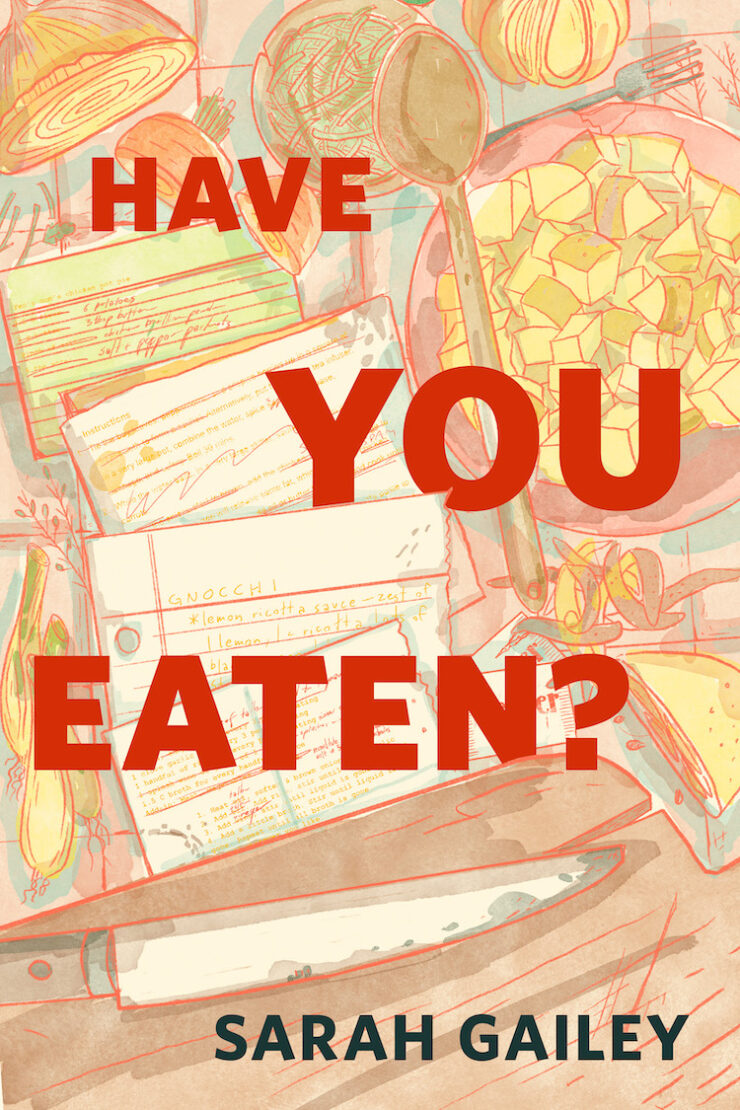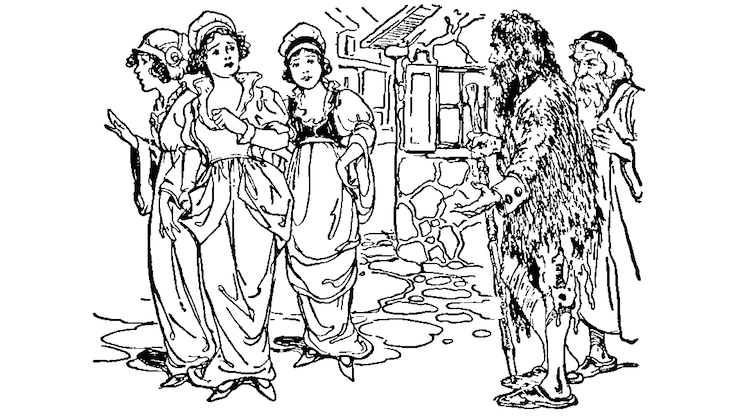After princesses, the most popular subject in western fairy tales might just be bears. Talking bears, transformed bears, bears able to use sign language, bears arousing questionable passions in young handsome princes, bears with somewhat questionable agendas, the occasional dead bear—you name the bear, and it’s probably in some fairy tale, somewhere. To the point where even a deal with the devil story ends up managing to involve a bear. A mostly dead bear, true, but, still, a bear.
Oh, and yes, make some indirect points about ensuring that soldiers receive some sort of income post-war and musing on the boundaries between humans, bears and monsters, but I choose to focus on the bear part.
Jacob and Wilhelm Grimm published the tale of “Bearskin” in their second volume of their first edition of Children’s and Household Tales in 1815. Like many of their tales, it was a heavily edited blend of two different tales, the first a short tale by the German author Hans Jakob Christoph von Grimmelshausen (1621—1676), author of what has been described as the first adventure novel written in German, Der abenteuerliche Simplicissimus Teutsch, (either the The Adventurous Simplicissimus or Simplicius Simplicissimus in English), published in 1669, and the second an oral tale collected by the Grimms from the Haxhausten family, who may have derived their version from Grimmelshausen. As with virtually all of their tales, the Grimms added their own touches, and later revised the story still further, particularly in their 1843 edition.
The story opens on a theme all too familiar to the Grimms and Grimmelshausen and presumably the Haxhaustens: a homeless soldier. Grimmelshousen had personally experienced this: forcibly recruited into the Hessian Army to fight in the Thirty Years War, he later worked a number of different administrative jobs, at least one of which seems to have paid so poorly that he ended up embezzling from his employers. The Grimm brothers avoided conscription, but knew several former soldiers, many disabled, many others lacking job skills and having difficulties finding employment both during and after the Napoleonic Wars. Many of their tales feature such soldiers as protagonists.
The cynical Grimmelhousen made his soldier a deserter from a 1346 war against the Turks—thus, a failure in both a military and religious sense. The Huxhaustens, following fairy tale tradition, made this soldier the youngest of three sons. The Grimms, concerned as always about presenting German values in a positive light, and also concerned with the plight of homeless, unemployed soldiers—nearly everywhere after the Napoleonic Wars—turned Grimmelshousen’s deserter into a brave soldier, always willing to face the first rain of bullets, fully deserving of a happy fairy tale ending.
Incidentally, both the bullets in the Grimm version and the very specific year in the Grimmelhousen version root this story, whatever its supernatural touches, very much in the real world—even if Grimmelhousen later slightly undermines the historical touches of his tale by saying that his protagonist has access to unlimited tobacco, something not exactly widely available in Europe in 1346. The point is, this soldier is not a protagonist from an otherworldly place, or even the aristocracy (equally fantastic to many readers of these tales), but a realistic character, someone readers could presumably meet in their own world.
And a character without money. As with many of the soldiers the authors knew, no one will hire him, and he is no longer receiving regular meals from the army, let alone a salary. He comes close to starving. Which is about when he encounters a well-dressed man with a cloven foot wearing a bright green coat. May I just say that I appreciate that the devil has taken the time and care to dress up for this temptation, even though that much care is probably not necessary, plus chosen to wear a nice cheerful color so that this encounter functions both as a temptation and as a bit of much needed therapy. I like professionalism in my devils, not to mention a bit of consideration for the spiritually weak. In the Grimmelhousen and Huxhausten versions, the devil moves right into the temptation business, all while holding a bearskin. The Grimms, still focused on painting German ex-soldiers in a positive light, start by having the devil test the soldier’s courage by having him shoot a bear, and all of the sympathy and appreciation that I just had for this devil? Gone. I mean, really, devil, what did this poor bear do to you?
With the bear now safely dead, or with the bearskin already in hand, the devil presents his offer: If the soldier can survive for seven years without bathing, cutting his hair or nails or praying, and agrees to wear the skin of the bear throughout this period, at the end of this, the devil will ensure that the soldier will be wealthy and free for the rest of his life.
Since this the best offer that the soldier has heard since the end of the war, he leaps for it. All goes well for the first year, especially since the devil has provided the man with a bottomless purse (and a lot of tobacco in the Grimmelhousen version). After all, the soldier is hardly the only homeless ex-soldier with presumably irregular bathing habits roaming around Europe at this point, but he presumably is the only one with this sort of money. By the second year, however, Bearskin is distinctly unpleasant. By the fourth year, innkeepers are none too politely telling him to stay out by the outhouses.
It’s entirely possible that Bearskin might have given up at this point—he’s starting to have severe difficulties talking to people, which implies severe difficulties with obtaining food, and his sleeping arrangements are becoming interesting, to say the least. But at this point, he encounters another man in severe financial difficulties. That unlimited purse allows Bearskin to pour money into the old man’s hands. Apparently figuring that money makes anyone bearable, even weird dudes wearing bearskins who haven’t bathed for years, the old man offers Bearskin one of his three daughters.
The oldest daughter freaks out. The second, to my genuine alarm, points out that this is the family’s second encounter with some form of talking bear—the first one, granted, was shaved and wearing a nice Hussar uniform, but I gotta say, what were the odds of a single family encountering two talking bear things?
Run, Bearskin, run.
It falls, of course, to the third daughter to agree to marry Bearskin—though he is at least kind enough to assure her that the actual consummation of the marriage can wait until he has a shower, which will be another three years. In the meantime, he’ll just wander off. If he doesn’t return—well, she’s free. He breaks a ring in two, gives her half and keeps half, and heads off.
The next three years are unpleasant for pretty much everyone: Bearskin, who still can’t bathe or take off the bearskin, looking increasingly monstrous (real bears would probably get a kinder reception); the youngest daughter, who starts crying whenever she thinks about him; the older daughters, who, understandably not thrilled at the thought of welcoming this guy back into the fold, take out their issues on their younger sister, teasing her; and the devil, who definitely picked the wrong guy to tempt. Because the thought of that fortune—or, maybe, at this point, the youngest daughter—was enough to keep Bearskin wrapped in that fur. This is a story where the devil loses—and to add insult to insult, actually has to bathe Bearskin before handing over the unlimited wealth.
But not everything goes wrong for the devil. After a much cleaned up and now obviously wealthy Bearskin returns to the youngest daughter, and proves his identity with that broken ring, the older daughters commit suicide. Whether this is to prevent a third bear from making an appearance (my theory), or out of jealousy (Grimmelhousen’s theory, unhesitatingly accepted by the Grimms), or just out of despair in realizing that they have only two choices in life: complete obedience to their father’s wishes or eternal hellfire (a scholarly theory), as suicides, their souls belong to the devil. Meaning that although he lost the soldier’s soul, he gained two more—not a bad bargain on his part.
But a seemingly unfair one. After all, these are not exactly the wicked sisters of fairy tales: rather, they are two sisters who were first forced to watch as their father lost his fortune (the tales contain not a single hint that they had anything to do with this), then asked to marry bears and smelly quasi-bears, and then forced to wait for three years for a monster to return to their family—a monster, who, sure, now looks great and has plenty of money and some lovely horses, but also, and this is important, was willing to make a deal with the devil. And for all of their hard luck, the devil never comes to them with a choice, or an opportunity to suffer for years for the chance of a major reward at the end of it. Which is to say, their choice of suicide, however extreme it may seem at first glance, may also not be as unjustified as its storytellers want you to believe.
Which makes “Bearskin” a bit more than simply a tale of a successful deal with a devil, or yet another indication that western Europe had more than a bit of an obsession with bears. Rather, it is a tale of desperation, of showing what lengths people would go to in order to escape poverty, of the difficulties of releasing soldiers trained to do nothing other than kill into the world with nothing other than a gun, and of the limitations placed on women. It is a story where only some triumph—or even have the chance to triumph. But it is also a story that offers hope, that claims that wealth can come out of suffering, that even the devil can and will keep a bargain, that seemingly useless, broken soldiers can still rescue others, and that an arranged marriage does not need to be miserable. Realism and hope: possibly the very best reason to read fairy tales.
Mari Ness lives in central Florida.










